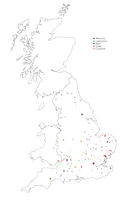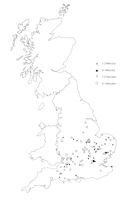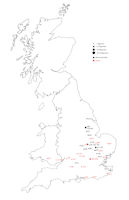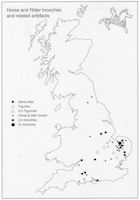


Figure 15: Distribution of Mercury figurines
Figure 16: Distribution of Mercury and associated figurines
Figure 17: Distribution of finds associated with Mercury and Hercules (after Jones and Mattingly 2002, map 8:6)
The two most popular deities, Mercury and Hercules, do both have a wide distribution. According to Caesar (B. Gall. 6.17) Mercury was the most popular god in Gaul and he would appear to be equally popular in Britain (Bruneaux 1988, 68-9; Oggiano-Bitar 1994; Crummy 2007, 225). His role as the patron of travellers and merchants meant that he would be widely venerated by these groups, but Mercury was also the guide to the underworld and as such was well disposed towards mankind (Henig 1995b, 57-8). Like the overall distribution of figurines, Mercury is concentrated in the southern zone, with smaller numbers following the road north to Hadrian's Wall (Figure 15). The western part of central England is largely devoid of finds. The distribution of Mercury as depicted in all media, primarily metal figurines and stone, on non-military sites as published by Green (1976, fig. 9) and Jones and Mattingly 2002, map 8:6 (here Figure 17) shows a definite concentration in the band across southern England. However, while the metal figurines are sparse in the central counties of Hampshire, Berkshire and Oxfordshire, they show a concentration in Gloucestershire, Wiltshire and Somerset. This is an area where Mercury is also commonly seen on stone sculpture and reliefs. If one adds the distribution of animals associated with Mercury, such as the goat, ram and cockerel, they further emphasise the southern distribution of the deity (Figure 16). However, they do have slightly different patterns. There is a thin scattering of ram figurines, all except one being north of the Thames/north Somerset border. All of the goats, except for unusual, stylised figure 883 from Dumbuck, West Dunbartonshire, are found south of the Wash/Severn border with a slight concentration in Norfolk and Suffolk. Cockerels, the creature most often associated with Mercury, are fairly widespread, but are not common in the south-west. A tortoise is depicted on the Mercury group 55 from St Albans, and there are two tortoise figurines from Colchester (1035) and Chester (679).



Figure 15: Distribution of Mercury figurines
Figure 16: Distribution of Mercury and associated figurines
Figure 17: Distribution of finds associated with Mercury and Hercules (after Jones and Mattingly 2002, map 8:6)
The widespread popularity of Mercury is further indicated by the distribution of his figurines on a variety of different site types. Jones and Mattingly (2002) concentrate on his depiction in the southern civilian zone, and their map (Figure 17) gives the impression that he was more popular among the civilian population. However, while the total number of figurines on civilian sites is higher, Figure 18 shows that he also occurs at military sites. The majority of military sites have only yielded single figurines of Mercury, but this mirrors the situation on most civilian sites. It is on many of the religious sites, including the temples at Colchester, Crownthorpe and possibly Great Walsingham, Norfolk; Lamyatt Beacon, Somerset; and Uley and the hoards from Southbroom and Exeter, where two or more Mercurys are found. The use of caducei as votive objects is also apparent in their concentration on religious sites associated with Mercury. All of the caducei in the religious group are from the temple at Uley, and those from Colchester were found at the temples on Balkerne Hill.
Finally, one must consider that figurines may have been regularly carried by their owners and lost by accident. The presence of temples to Mercury at locations where travel was beginning or ending, such as the Balkerne Gate in Colchester (Crummy 2006), further emphasises his role as a patron of travellers and his widespread distribution may also be a reflection of this.
Hercules, the second most common figurine, also has a widespread distribution from the south coast to Hadrian's Wall, but he is primarily found across the southern zone with only a thin scattering of finds further north (Figure 19). Green (1976, 70) suggests that Hercules was more popular among the Catuvellauni on the eastern side of the country than the Dobunni to the west, and there are indeed slightly more figurines in the region of the Catuvellauni.
Unlike Mercury, only one Hercules figurine is known to have come from a religious site, the temple at Lamyatt Beacon (330). Instead Hercules shows a decidedly urban bias with 23 figurines and two clubs from the larger urban sites (particularly London, Colchester and St. Albans), but only two from small towns and one from a villa (Figure 20). He is also found in small numbers on military sites.
Figurines of Mars and Jupiter are also fairly widespread throughout Britain, but while Jupiter (Figure 21) appears as a small scatter throughout the country, Mars (Figure 22) is, surprisingly, concentrated in the southern zone. The popularity of Mars and Jupiter in the northern military zone is attested by the high numbers of stone dedications to these gods, especially along Hadrian's Wall (Jones and Mattingly 2002, 267 and maps 8.2-8.5). This suggests that it is not their popularity, but the style of worship of these two gods that differs between the civilian and military populations and that Mars was also venerated by the civilian population in the south. Although Mars is found on a variety of settlement and military sites, only one figurine of Mars has been found at a temple (328 from Lamyatt Beacon). In addition, Mars 27 was found in the hoard from Barkway, which also contained plaques with dedications to Mars. Similar dedications have been found at other sites such as Lydney (Wheeler and Wheeler 1932, 100-1) and Uley (Tomlin 1993, 115), which indicate that he was being venerated on these sites.
Jupiter is commonly associated with the eagle, which also occurs in small numbers throughout Britain. However, it should be noted that of the six eagle figurines from religious sites, five are from the temple at Woodeaton. In addition, all of the urban sites, other than London, which have produced Jupiter figurines also have a considerable military presence, a fact which strengthens the association of Jupiter with the military.


Figure 23: Distribution of Horse and rider and Horse figurines
Figure 24: Distribution of horse and rider objects (Eckardt 2005, fig. 6)
Apart from classical depictions of Mars, horse and rider figurines are commonly thought to be a provincial representation of Mars. These figurines (Figure 23) are predominantly found in eastern central Britain, as Green (1976, 70) suggests in the area of the Catuvellauni and Corieltauvi. Horses with no apparent riders are also decidedly concentrated in a narrow band across southern England. This distribution is further emphasised by the distribution of other horse and rider artefacts, such as brooches and altars (Figure 24).
Horse and rider figurines occur on a small range of site types, primarily small towns and religious sites. In particular, four horse and riders (7, 158, 159 and 46 and 160 which although found separately appear to belong together) and Horse 47 have been found at the temple at Brigstock, Northamptonshire. Two horse and rider figurines (161 and 162) were also part of the Willingham Fen hoard. No horse and rider figurines have been found at the major urban centres of London, Colchester or St Albans. As a provincial god, one might expect to find examples on rural settlement or villa sites, although it is possible that some of those figurines from unknown sites may belong to these categories.
The final male deities with widespread appeal are Bacchus, along with his associates such as satyrs, and Cupid. Bacchic figures occur in a scatter across Britain, although none have been found in Wales, and there is a small concentration in Essex (Figure 25). Bacchus appears in small numbers at all civilian sites except isolated temples. Hutchinson (1986, 99) found that Bacchic material was particularly concentrated in London, Colchester, Wroxeter and Cirencester; however, figurines were only recovered from London and Colchester. She also found high proportions of Bacchic objects on military sites (Hutchinson 1986, 97), which is reflected in the slightly higher number of figurines. In addition, the panther, an animal often associated with Bacchus, occurs once at London and three times on military sites.
Cupid appears both in the southern zone, with a small concentration in Essex and Sussex, and in the northern military zone (Figure 25). Like Bacchus, no Cupid figurines have been found on religious sites, but they occur on a full range of other site types. Figurines from Caerleon, Corbridge, Chester and York are all from unknown contexts and so could be from urban or military contexts. Of some interest are figurines of Cupid in flight with a fairly long torso and arms. These have been found at Corbridge (224), Piercebridge (697), Kirkby Thore (257) and Moresby (267). They differ somewhat from the slightly chubby, shorter and more common version of Cupid seen elsewhere and suggest the presence of a workshop located somewhere in the north. This might account for the higher numbers on military sites, although whether they were being produced to satisfy a demand or appear more often due to increased availability one cannot tell.
Apollo is decidedly southern in his distribution, and, until recently, no figurines had been found north of the Humber or in East Anglia (Figure 26). He also occurs on a limited range of, usually urban, sites such as London, St Albans, Exeter, Lincoln and Wroxeter. In addition one figure is associated with the temple at Woodeaton and two from the Saxon shore forts of Richborough and Portchester. While no figurines of Apollo appear in Suffolk or Norfolk, a slight concentration of Priapus figures occurs in that region (Figure 26). Priapus figurines occur in a scatter that spans the length of Britain, but is largely concentrated towards the eastern side of the country. Apart from the geographical patterning, Priapus figurines occur in a variety of styles and site types. Unfortunately, many of the figurines are from unexplored or unknown sites, which suggests that they are likely to be rural or villa sites. There are also no Priapus figurines from any of the larger urban sites except Chichester. The small numbers of both Apollo and Priapus figurines means that their distribution could just be due to chance. This is exemplified by the recent discovery of Apollo 1188 at Hayton, E. Yorkshire, which pushed the distribution of the deity north of the Humber. However, the large number of other figurines from East Anglia suggests that his absence from that area is not down to chance.
Genii, Lares and worshippers or priests are here considered together due to their role in Roman familial religion. The distribution of all three types is concentrated in a narrow band across southern Britain, with a small group near Hadrian's Wall and three from York (Figure 27). These figurines are highly classical in style, the Genii and priests often wearing togas, sometimes fully draped, and the lares short tunics. However, the quality of the pieces is variable and does include several cruder, probably locally produced examples from Earith (675) and Ely (108), Cambridgeshire and Badbury, Wiltshire (862).
The numbers are, as ever, small (17 Genii, 18 Lares, 11 worshippers). Unfortunately 16 of the figurines are from unknown sites, although many of these are likely to be rural settlements or villas. London and Silchester have only single examples of the Genius paterfamilias and none have been found at Colchester or any small towns. One Genius was found in a religious context, at the temple on Lamyatt Beacon. The group of figurines from this temple are all highly classical in style so this Genius is not necessarily out of place. Of more interest is the inclusion of a Genius, now lost, in the Southbroom hoard which contained a mix of classical and provincial pieces and included a number of highly individual and unusual figurines.
The total number of Lares is similar to that of Genii, but slightly more have been assigned to site types, and they do appear to be more evenly spread across these types than the Genii. The worshippers or priests form the smallest group, and the only one for which all of the figures have been assigned a site type, thus the slightly higher numbers from military and urban sites is significant.
© Internet Archaeology/Author(s)
University of York legal statements | Terms and Conditions
| File last updated: Tue Mar 20 2012